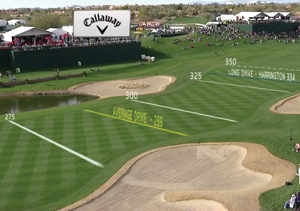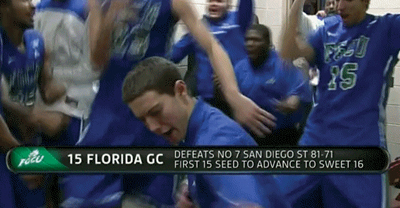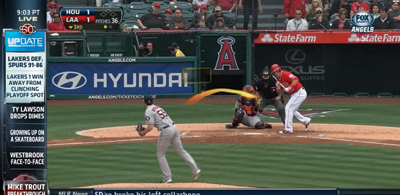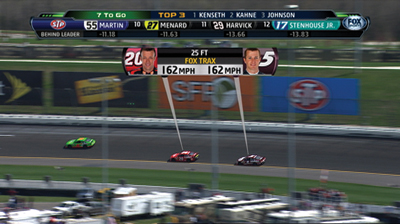Golf Channel’s Callaway Driving Grid
Golf Channel first used the Driving Grid this year in Maui at the Hyundai Tournament of Champions. The technology was used on the 18th hole, which features the course’s longest drives thanks to a downhill tee shot and wind blowing behind the player.
Golf Channel’s lead producer, Tommy Roy, wanted to use on-screen graphics to show viewers how far the pros’ drives
traveled as soon as the ball came to a stop.
Using data from the Shot-Link scoring and statistical data system, producers could click on the ball when it stopped, and the yardage of the drive would pop up. SportsMedia Technology applied the technology.
“My idea was just to use it on that one hole for that one tournament,” Roy said.
Sponsors loved it, however, so Golf Channel’s ad sales team sold a sponsorship around it to Callaway. Roy’s plan to use the technology as a one-off was expanded to include most Golf Channel tournaments — including all PGA Tour tournaments on the network — this year.
In each tournament, Golf Channel will use the technology on one hole. Roy said the hole typically will be a dog-leg that will allow the network to place a camera at least 100 feet above the hole.
“We want to pick a hole where golfers are going to be ripping it with their driver,” Roy said. “If they are all using a 3-wood, it wouldn’t be nearly as effective.”
Eventually, Roy believes the technology can be used on par 3s, showing how close tee shots are to the hole as soon as the ball stops moving. “Any time you can enhance the viewing experience for somebody, it’s helpful,” Roy said.
Turner’s embedded cameras
After Florida Gulf Coast University defeated San Diego State University to advance to the NCAA Tournament’s Sweet 16 this year, TBS viewers got to see the jubilant team as it entered the locker room at Philadelphia’s Wells Fargo Center.
In one of the defining scenes from the tournament, players, coaches and managers from the upstart team broke out into impromptu dance moves — showing a mix of joy and bravado.
The pictures were relayed nationally to TBS viewers from a small camera embedded in the locker room and demonstrated a philosophy Turner Sports brings to producing its sports telecasts.
“It wasn’t a new technology, but it was an innovative mindset,” said Craig Barry, senior vice president of production for Turner Sports. “I believe in bringing the broadcast as close to the fan as possible. This is a way to get fans to places that they wouldn’t get to go.”
It’s not just with cameras. Turner has worked extensively with the NBA to put microphones on players and embed small cameras in strategic places around the arena. Turner is talking with MLB about doing the same for its baseball telecasts.
In coming years, Barry believes that leagues and teams will do more to embed cameras and microphones at games.
“People are going to insist on being closer to the game and closer to the court in all sports,” he said. “Leagues are finding that there’s a value to being better connected to players, teams and leagues.”
ESPN’s Orad MVP
Several years ago, ESPN realized that it’s not enough to just show highlights on “SportsCenter,” particularly when fans can access them on the Internet.
In 2011, “SportsCenter” producers started using a graphics platform from Orad to help it graphically show the stories
behind the highlights. We know Vikings running back Adrian Peterson is fast, but now “SportsCenter” can say exactly how fast.
ESPN uses Orad technology for its tennis and “Monday Night Football” coverage, too. It has used Orad technology since 2010 in its MLS telecasts, usually to better illustrate the offsides line.
Essentially, Orad helps track plays and players and is able to follow the path of an object or person. How much does a curve ball break? Orad’s technology can demonstrate.
“We obviously place a huge emphasis on our highlights,” said Michael Shiffman, senior coordinating producer for “SportsCenter.” “We can’t give the viewer just the plays as they’ve seen on the replay. We want to give the viewer a deeper and smarter experience.”
“SportsCenter” also uses other systems, like ProTracer, to show how long home runs travel. “SportsCenter” executives use focus groups to help them decide which new technologies to use and which ones to shelve, Shiffman said.
“We’re constantly looking for new techniques,” Shiffman said. “Right now looks different from a year ago.”
MLB Network’s Cisco Ballpark Cam
It was April 19, and the entire city of Boston was in lockdown as authorities searched for one of the men who set off bombs at the Boston Marathon.
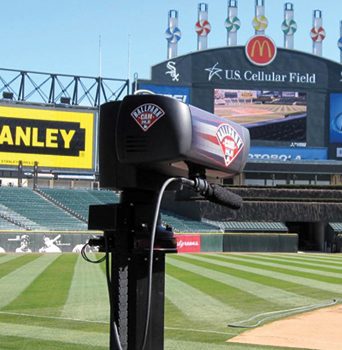 |
| Photo by: MLB Network |
The Red Sox game scheduled for that night already had been canceled, but some players were locked down at Fenway Park, so they began throwing the ball on the field. MLB Network producers took it all in thanks to the network’s innovative Ballpark Cam, which the network has set up in every MLB ballpark.
Each MLB ballpark is outfitted with two robotically controlled cameras — one in a dugout and one in center field. MLB Network producers control the cameras from their Secaucus, N.J., studios. The center-field cameras are equipped with wipers to clear the lens when it rains. The dugout cameras are in the home dugout for all but a handful of stadiums, where they are in the visitors dugout.
“It’s almost like a video game,” said Susan Stone, MLB Network’s senior vice president of operations and engineering. “It’s how we get the majority of our content.”
MLB Network President Tony Petitti and Ken Aagaard, CBS Sports executive vice president of engineering, operations and production services, hatched the idea of the Ballpark Cam alongside the launch of the network in 2009. MLB Network uses the cameras for its pregame show and postgame interviews. It also presents live look-ins using the cameras.
“It helps us show a deeper, richer narrative of the game,” Stone said. “It helps us humanize what’s going on around the game.”
Fox Sports’ pointers
Fox Sports had been using “pointers” technology on its NASCAR coverage to help viewers identify cars during replays when, last year, it started using the technology during its NFL and postseason MLB telecasts.
For NFL games, when a game analyst discussed a wide receiver or a lineman, producers used the technology to identify
the player with an on-screen bug that pointed to the player and provided statistics. For MLB games, the technology was used during overhead shots to identify who was on base and who is in the field.
The pointers technology was a collaborative project between ChyronHego, Sportvision and Fox Sports Media Group. It primarily is used during replays. Eventually, Fox Sports executives hope to use it during live action.
“We want to move into getting this into the soccer world,” said John Entz, executive vice president of production and executive producer at Fox Sports. “It’s something that applies to multiple sports and allows us to dive in as deep as we can.”
The system works best when an announcer talks about a player, allowing a producer to call up the pointer on him, complete with statistics. Before it can be used widely on live action, Entz said, “We need to improve the accuracy and efficiency of it.”
Fox Sports executives like the technology and believe it adds to the telecast. But they say they will not roll out new technology just to show off new bells and whistles.
“We’ll keep experimenting with it to see how the live portion looks when compared to the replays,” Entz said. “For every three to four technological advances, probably one or less is actually successful. Even though you can do it doesn’t mean you should do it.”


